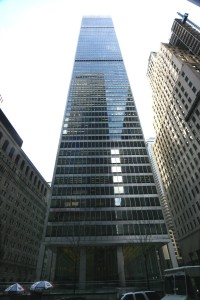
One Chase Plaza. Image credit: LPC
Project would alter the solid black-granite base to create retail storefronts, and make for a more inviting and accessible plaza. On May 5, 2015, the Landmarks Preservation Commission held a hearing on potential alterations to the individually landmarked One Chase Manhattan Plaza at 16 Liberty Street in Lower Manhattan. The designated site consists of a 60-story tower and associated two-and-a-half-acre plaza, designed by the firm of Skidmore, Owings & Merrill. The project was led by partner Gordon Bunschaft, the same team behind other City landmarks, including the Lever House and the Manufacturer’s Trust Building. The project was completed in 1964 as the headquarters for Chase Manhattan Bank, recently formed by a merger of Chase Bank and the Bank of Manhattan.
The International Style tower was the largest building constructed in the City for over 25 years, and featured a sheer curtain wall. The base of the building is faced in black granite panels. Five levels of the sixty-story tower are below the level of the plaza. The plaza incorporates a sunken garden by sculptor Isamu Noguchi, as well as plantings and seating. Landmarks designated the complex an individual City landmark in 2009.
JP Morgan Chase recently sold the building and plaza to China-based investor Fosun. Fosun’s Managing Director Erik Horvat stated the building use would primarily remain as office space, but lower levels, including the bank lobby, would be converted to retail space. He said the firm was “deeply respectful of this building and what it means to Lowe Manhattan,” and claimed the modifications would “re-energize” the lower levels of the building as well as the plaza.
Architect Frank Mahan, of SOM, formerly known as Skidmore, Owings & Merrill, said the team had researched the original design intent in the firm’s archives. He noted that most elements of the plaza, outside of the artwork, were non-original, created through renovations done prior to landmarking. The plaza would be restored to its original square footage, having lost ground to mechanical equipment in the intervening years. A new sculpture or installation by an “A-list artist” would be located in the renovated plaza. Walls paneled with black granite at the plaza’s base would be partially replaced with glass storefront infill. The proposal would retain and maintain Noguchi’s sunken garden.
Mahan said the neighborhood surrounding the plaza had changed significantly since 1964, when the plaza essentially served as a place for office workers to eat their lunch, while the area now had a significant residential component, and was “a 24-hour neighborhood.” The new plaza would be safe and inviting place for people after dark, as well as during the day, and would be utilized as a site for cultural activities. New lighting would be installed to accommodate planned nighttime use, as well as to illuminate the retail storefronts. Ramps for the handicapped and two new stairways would be created to ease access to the plaza.
A representative of the New York Chapter of the American Institute of Architects testified in favor in of the application, saying it would engage the public and “renew public appreciation” of the landmark. The Downtown Alliance’s Taina Prado said the proposal would “enliven and activate the plaza, the building, and surrounding blocks.”
Kelly Carrol of the Historic District Council spoke in opposition, saying the black granite was “integral to the perception of this massive building,” and its replacement with glass storefronts was an “insult” to the landmark. Landscape architect Michael Gotkin called the proposed changes “incredibly disruptive,” and noted that there were many forms of adaptive reuse that would not require new storefront windows.
Landmarks Chair Meenakshi Srinivasan stated that Manhattan Community Board 1 had submitted a resolution in general support of the project, asking that the new lighting be modified so not to affect nearby dwellings. Srinivasan said the Municipal Art Society, Docomomo and the Landmarks Conservancy had also submitted letters raising concerns about different aspects of the proposal.
Commissioner Michael Goldblum found the new glass storefront at the building base to give the building a “floating” appearance, significantly changing the intent of the original design. Fred Bland remarked on the “two visions of a public space by one firm,” but found the project generally approvable, noting that cities evolve and change, and the current experience of the base was “unfriendly.” Commissioner Kim Vauss questioned the necessity of the amount of new glass being added to the landmark in the proposal. Commissioner Adi Shamir-Baron cautioned against disposing of the uniquely Modernist qualities that defined the landmark.
Chair Srinivasan said that individual landmarks could be altered to meet changing needs, and that “enlivening the street level pedestrian environment” was important to the neighborhood, but changes needed to be justified. Srinivasan particularly identified the “wholesale…removal” of the black granite at the plaza’s base as problematic. She asked the applicants to rethink the proposal’s lighting, and the amount of glazing at the base, and return to Landmarks at a later date.
LPC: One Chase Manhattan Plaza, 28 Liberty Street, Manhattan (16-8200) (May 5, 2015) (Architects: SOM).
By: Jesse Denno (Jesse is a full-time staff writer at the Center for NYC Law)

